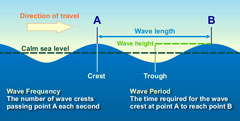Waves
Currents Tutorial
Coastal currents are intricately tied to winds, waves, and land formations. Winds that blow along the shoreline—longshore winds—affect waves and, therefore, currents.
Before one can understand any type of surface current, one must understand how wind and waves operate. Wave height is affected by wind speed, wind duration (or how long the wind blows), and fetch, which is the distance over water that the wind blows in a single direction. If wind speed is slow, only small waves result, regardless of wind duration or fetch. If the wind speed is great but it only blows for a few minutes, no large waves will result even if the wind speed is strong and fetch is unlimited. Also, if strong winds blow for a long period of time but over a short fetch, no large waves form. Large waves occur only when all three factors combine (Duxbury, et al, 2002.)
As wind-driven waves approach the shore, friction between the sea floor and the water causes the water to form increasingly steep angles. Waves that become too steep and unstable are termed “breakers” or “breaking waves.”
Currents Lessons
- Welcome
- Tidal Currents 1
- Tidal Currents 2
- Waves
- Longshore Currents
- Rip Currents
- Upwelling
- The Coriolis Effect
- Surface Ocean Currents
- Boundary Currents
- The Ekman Spiral
- Thermohaline Circulation
- The Global Conveyor Belt
- Effects of Climate Change
- Age of Exploration
- What is a "knot"?
- Shallow Water Drifter
- Deep Ocean Drifter
- Current Profiler
- Shore-based Current Meters
- How Currents Affect Our Lives?
- References
- Roadmap to Resources
- Subject Review
